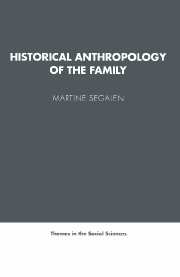1 - THE DOMESTIC GROUP
Published online by Cambridge University Press: 14 January 2010
Summary
Starting from the basis of the most ordinary experience, we begin this study by examining the domestic group. By a domestic group we mean a set of people sharing the same living-space. Cohabitation and shared residence is a crucial element in our definition.
The living-space may also be a place of work and production, such as a farm, an artisan's workshop or a shop. For most modern Western families, it may be no more than a place of relaxation, of social activity and consumption. In this way, the nature of the shared space may change, as may the group sharing it.
The associated idea of the nuclear family, which is more restricted than that of the domestic group, refers essentially to the married couple and their children. Some domestic groups may consist of a single nuclear family, others of several, perhaps combining several married couples with either filial links (aged parents and married children) or collateral ones (couples of brothers and sisters). The domestic group, in addition to one or more nuclear families, might include people without kinship links either taking part in its productive activity, such as servants, journeymen or apprentices, or not, as in the case of tenants, lodgers and so forth. If the concept of the domestic group is clearly a wider one than that of the nuclear family, how does it stand in relation to that of the household (which has the advantage of referring to residence, house, hearth), an ancient term used when calculating the number of families? ‘Household’ is not used here, ‘domestic group’, which is a wider and more neutral expression, being preferred.
- Type
- Chapter
- Information
- Historical Anthropology of the Family , pp. 13 - 42Publisher: Cambridge University PressPrint publication year: 1986
- 1
- Cited by

